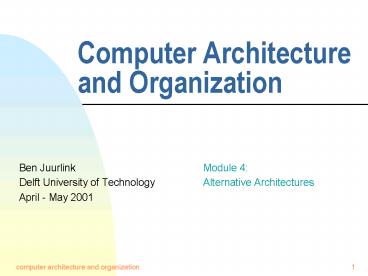Computer Architecture and Organization - PowerPoint PPT Presentation
1 / 13
Title:
Computer Architecture and Organization
Description:
'This history illustrates the impact of the 'golden handcuffs' of compatibility ' ... 'an architecture that is difficult to explain and impossible to love' ... – PowerPoint PPT presentation
Number of Views:57
Avg rating:3.0/5.0
Title: Computer Architecture and Organization
1
Computer Architecture and Organization
- Ben Juurlink Module 4
- Delft University of Technology Alternative
Architectures - April - May 2001
2
Objectives
- After this lecture, you should
- know some alternatives to the MIPS instruction
set - know the major differences between MIPS,
x86/IA-32, 8051 and Java bytecode - be able to read IA-32 assembly
- be able to program 8051 assembly
- be able to translate an expression to Java
bytecode - know the following terms
- two-address instruction format
- condition codes
- accumulator architecture
- stack architecture
- translation vs. interpretation
3
Alternative Architectures
- Design alternatives
- provide more powerful operations
- goal is to reduce number of instructions executed
- danger is a slower cycle time and/or a higher CPI
- provide even simpler operations
- to reduce code size / complexity interpreter
- Sometimes referred to as RISC vs. CISC
- virtually all new instruction sets since 1982
have been RISC - VAX minimize code size, make assembly language
easy instructions from 1 to 54 bytes long! - Well look at x86/IA-32, 8051 and Java bytecode
4
A dominant architecture x86/IA-32
- A bit of history
- 1978 The Intel 8086 is announced (16 bit
architecture) - 1980 The 8087 floating point coprocessor is
added - 1981 IBM PC was launched, equipped with the
Intel 8088 - 1982 The 80286 increases address space to 24
bits new instructions - 1985 The 80386 extends to 32 bits, new
addressing modes - 1989-1995 The 80486, Pentium, Pentium Pro add a
few instructions (mostly designed for higher
performance) - 1997 MMX is addedThis history illustrates
the impact of the golden handcuffs of
compatibilityadding new features as someone
might add clothing to a packed bagan
architecture that is difficult to explain and
impossible to love
5
IA-32 Overview
- Complexity
- Instructions from 1 to 17 bytes long
- two-address instructions one operand must act as
both a source and destination - ADD EAX,EBX EAX EAXEBX
- one operand can come from memory
- complex addressing modes e.g., base or scaled
index with 8 or 32 bit displacement - Saving grace
- the most frequently used instructions are not too
difficult to build - compilers avoid the portions of the architecture
that are slow - what the 80x86 lacks in style is made up in
quantity, making it beautiful from the right
perspective
6
IA-32 Registers
8
8
16
AX
AH
AL
EAX
general purpose registers
BX
BH
BL
EBX
CX
CH
CL
ECX
DX
DH
DL
EDX
index registers
ESI
EDI
pointer registers
EBP
ESP
CS
SS
segment registers
DS
ES
FS
GS
EIP
PC
EFLAGS
condition codes (a.o.)
7
IA-32 Addressing Modes
- Addressing modes where are the operands?
- Immediate
- MOV EAX,10 EAX 10
- Direct
- MOV EAX,I EAX Memi
- I DW 3
- Register
- MOV EAX,EBX EAX EBX
- Register indirect
- MOV EAX,EBX EAX MemoryEBX
- Based with 8- or 32-bit displacement
- MOV EAX,EBX8 EAX MemEBX8
- Based with scaled index
- MOV EAX,ECXEBX EAX MemEBX2scalexECX
- Based plus scaled index with 8- or 32-bit
displacement - MOV EAX,ECXEBX8
8
IA-32 Addressing Modes
- Not all modes apply to all instructions
- one of the operands must be a register
- Not all registers can be used in all modes
- Why? Simply not enough bits in the instruction
9
Control
- Many instructions set condition codes in EFLAGS
register - Some condition codes
- sign set if the result of an operation was
negative - zero set if the result was zero
- carry set if the operation had a carry out
- overflow set if the operation caused an overflow
- parity set when result had even parity
- Subsequent conditional branch instructions test
condition codes to determine if they should jump
or not
10
Control
- Special instruction compare
- CMP SRC1,SRC2 set ccs based on SRC1-SRC2
- Example
- for (i0 ilt10 i)
- ai
- MOV EAX,0 EAX i 0
- _L CMP EAX,10 if (ilt10)
- JNL _EXIT jump to _EXIT if igt10
- INC EBX MemEBX(ai)
- ADD EBX,4 EBX ai1
- INC EAX EAX
- JMP _L goto _L
- _EXIT ...
11
Control
- Peculiar control instruction
- LOOP _LABEL decrease ECX, if (ECX!0) goto
_LABEL - Previous example rewritten
- MOV ECX,10
- _L INC EBX
- ADD EBX,4
- LOOP _L
- Less instructions, but LOOP is slow
12
Procedures/functions
- Instructions
- CALL AProcedure push return address on stack
- and goto AProcedure
- RET pop return address from stack
- and jump to it
- EBP is used as a frame pointer which points to a
fixed location within stack frame - Special instructions
- PUSH EAX ESP - 4, MemESP EAX
- POP EAX EAX MemESP, ESP 4
13
IA-32 Machine Language
- IA-32 instruction formats
Bytes
0-5
1-2
0-1
0-1
0-4
0-4
prefix
opcode
mode
sib
displ
imm
6
1
1
Bits
2
3
3
Bits
Source operand
2
3
3
Bits
scale
index
base
Byte/word
mod
reg
r/m































